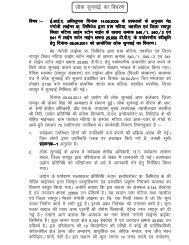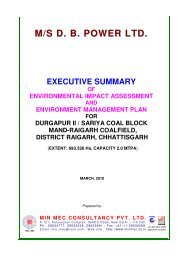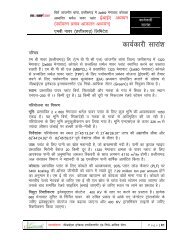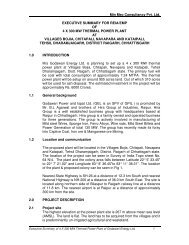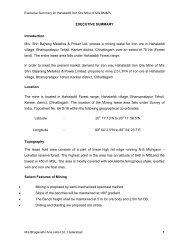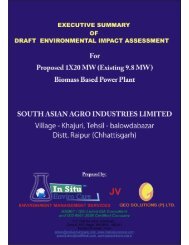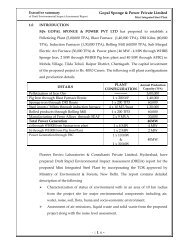Summary EIA Report in English Language - Chhattisgarh ...
Summary EIA Report in English Language - Chhattisgarh ...
Summary EIA Report in English Language - Chhattisgarh ...
You also want an ePaper? Increase the reach of your titles
YUMPU automatically turns print PDFs into web optimized ePapers that Google loves.
RAPID ENVIRONMENTAL IMPACT ASSESSMENTfor540 (4 x 135) MW Coal Based Power PlantatSalora, Chhuri, Gangpur, Darrabhata & Jhora, Tahsil – Katghora,District Korba, <strong>Chhattisgarh</strong>Executive <strong>Summary</strong>Sponsor :M/s Vandana Vidhyut Limited“Vandana Bhawan”M.G. Road, Raipur <strong>Chhattisgarh</strong>Prepared by :ANACLABORATORIES PVT. LTD.Recognised by MoEF (GOI) Notifn. No. D.L.33004/99 Dt.24.10.200760, Bajiprabhu Nagar, Nagpur – 440 033Ph. : (0712) 2242077, 9373287475 Fax : (0712) 2242077Email : anaconngp@gmail.com, anacon_ngp@sancharnet.<strong>in</strong>,Website : www.anacongarway.comNMay,2008
Executive <strong>Summary</strong>Executive <strong>Summary</strong>IntroductionThe state of <strong>Chhattisgarh</strong> was carved out of the state of Madhya Pradesh on 1 stNovember, 2000. <strong>Chhattisgarh</strong> is endowed with rich m<strong>in</strong>eral resources ma<strong>in</strong>ly coal.Before the creation of the renewed thrust on <strong>in</strong>dustrialization, the power demand isestimated to <strong>in</strong>crease at an accelerated pace and to cater to this demand, the stategovernment has adopted an aggressive policy for addition of power generation capacity <strong>in</strong>the immediate future. Government is also try<strong>in</strong>g to achieve a rate of growth of GDP of8-10% p.a. <strong>in</strong> near future. In order to support that growth rate, power supply needs togrow at a rate of over 10-11% p.a. Also by utiliz<strong>in</strong>g the rich coal deposits <strong>in</strong> the state, thestate <strong>in</strong>tends to become a power hub and supply power to power deficit states <strong>in</strong> thewestern regions and other regions.The liberalized policy launched <strong>in</strong> 1991 to encourage private sector participation<strong>in</strong> power generation permitted private developers to establish power projects both<strong>in</strong>dependently and <strong>in</strong> the jo<strong>in</strong>t sector through public/private participation <strong>in</strong> the powersector.Electricity Act, 2003 has ushered paradigm shifts <strong>in</strong> the power sector.Competition will be possible not just <strong>in</strong> generation, but also <strong>in</strong> every facet of the sector<strong>in</strong>clud<strong>in</strong>g transmission and distribution. Private sector <strong>in</strong>vestment will be facilitated bygreater transparency. The Act permits free entry <strong>in</strong>to generation unless there areoverrid<strong>in</strong>g safety and environmental concerns. The Act also promises non-discrim<strong>in</strong>atoryopen access to the transmission system. To this end, the Central Electricity RegulatoryCommission has framed the regulation for the “Open Access <strong>in</strong> <strong>in</strong>ter-state Transmission’<strong>in</strong> January, 2004. This will facilitate the bulk sale of energy from generators to thecustomers and will end the problems of the s<strong>in</strong>gle buyer model. This has <strong>in</strong>troduced theidea of trad<strong>in</strong>g <strong>in</strong> wholesale electricity. Open access thus would encourage and enableprivate <strong>in</strong>vestors to enter <strong>in</strong>to power generation and sell it directly to consumers. Thiswould beg<strong>in</strong> with bulk consumers and gradually extend up to the householders.Consider<strong>in</strong>g the above power scenario <strong>in</strong> the State of <strong>Chhattisgarh</strong> & WesternRegion, the need for sett<strong>in</strong>g up of the 540 MW (4 x 135 MW) power plant <strong>in</strong> <strong>Chhattisgarh</strong>by M/s Vandana Vidhyut Limited (VVL) is justified.VVL has reta<strong>in</strong>ed Anacon Laboratories, Nagpur to undertake an EnvironmentalImpact Assessment study for the proposed 540 MW Thermal Power Plant and suggest aneffective environmental management plan for m<strong>in</strong>imiz<strong>in</strong>g the adverse environmentalimpacts of the project.1.0 Project DescriptionSite DetailsThe proposed power plant will come up at village Salora, Chhuri, Gangpur,Darrabhata & Jhora, Tahsil Katghora, District Korba, <strong>Chhattisgarh</strong>. The site admeasur<strong>in</strong>g264 ha is located at 22 o 28’55.15 to 22 o 29’55.87 N latitude & 82 o 36’2.3” to82 o 37’0.6”E Longitude. The plant site has been selected based on the availability of fuel, water andfacilities for power evacuation. Figure-1 <strong>in</strong>dicates the project site and other featureswith<strong>in</strong> 10km around it.1
Executive <strong>Summary</strong>Thermal Power Generation ProcessIn combustion process, energy of fuel is converted <strong>in</strong>to thermal energy, which isthen converted <strong>in</strong>to mechanical energy through a turb<strong>in</strong>e and f<strong>in</strong>ally <strong>in</strong>to electrical energythrough generator. The boiler walls are l<strong>in</strong>ed with tubes conta<strong>in</strong><strong>in</strong>g high qualitydem<strong>in</strong>eralised water (known as boiler feed water). The combustion heat released from thefuel is absorbed by the boiler tubes and the heat converts the boiler feed water <strong>in</strong>to steamat high pressure and temperature. The steam discharged through nozzles on the turb<strong>in</strong>eblades rotates the turb<strong>in</strong>e, which <strong>in</strong> turn is coupled to a generator. Electricity producedwill be passed through a step-up transformer and power then be evacuated via switch yardthrough a transmission system.2.0 Description of the EnvironmentThe basel<strong>in</strong>e environmental quality data for various components of environment,viz. Air, Noise, Water, Land and Socio-economic were generated dur<strong>in</strong>g December 2007to February 2008 <strong>in</strong> the study area cover<strong>in</strong>g 10 km around the project site. Otherenvironmental data on flora and fauna, land-use pattern, forest etc were also generatedthrough field surveys and also collected from different state Govt. Department.2.1 Air EnvironmentAmbient air quality was monitored at 12 locations. Results <strong>in</strong>dicate thatconcentrations of SPM, RPM, SO2, NOx and CO are well with<strong>in</strong> the prescribedstandards.SPM - 89 to 204 µg/m 3RPM - 33 to 77 µg/m 3SO2 - 5.8 to 12.4 µg/m 3NOx - 8.3 – 14.5 µg/m 3CO - < 100 µg/m 3An automatic weather monitor<strong>in</strong>g station was <strong>in</strong>stalled at the project site to recordmicro-meteorological data. Dom<strong>in</strong>ant w<strong>in</strong>d directions recorded are from N, NE and E.2.2 Noise EnvironmentThe noise levels <strong>in</strong> the study area are with<strong>in</strong> the prescribed standards. Noise levelsranges from 40.0 dB(A) to 48.0 dB(A) dur<strong>in</strong>g day time and 32.0 dB(A) to 44.0 dB(A) <strong>in</strong>the night time.2.3 Water EnvironmentGroundwater occurs <strong>in</strong> the area <strong>in</strong> the form of shallow occurr<strong>in</strong>g, unconf<strong>in</strong>edaquifer as well as semi-conf<strong>in</strong>ed, moderately deep aquifers. Groundwater developmenthas been estimated as 25.18% <strong>in</strong> the region. This region has been rated “safe” accord<strong>in</strong>gto the Central Groundwater Board, Govt. of India and the Groundwater Survey Circle,Govt. of <strong>Chhattisgarh</strong>It has been observed that all the physico-chemical parameters and heavy metals ofwater samples from surface and ground water are below the stipulated dr<strong>in</strong>k<strong>in</strong>g water2
Executive <strong>Summary</strong>standards. The pH, TDS, and Dissolved Oxygen of the surface water were found <strong>in</strong> rangeof 7.5– 7.6, 56-164 mg/lit and 6.2-6.4 mg/lit respectively, whereas the ground watershowed pH 7.10 -7.67, TDS 155-495 mg/lit.2.4 Land Environment2.5 SoilAbout 37% of the total study area is forest land, 36% is agricultural land, 11% iswaste land and the rema<strong>in</strong><strong>in</strong>g 16% is uncultivable land. .Land use pattern with<strong>in</strong> the study area is given below:Total Area ForestLandIrrigatedLandUnirrigatedLandCulturableWaste LandUnclutivatedLand26651 9763 518 9186 2900 4284The soil quality assessment was carried out at eight locations. The bulk density ofthe soil <strong>in</strong> the study area ranges between 1.32 to 1.43 g/cc, which <strong>in</strong>dicate favorablephysical condition for plant growth. The porosity and water hold<strong>in</strong>g capacity of the soilsare <strong>in</strong> the range of 34.65% to 40% and 31.62 % to 38.66% respectively. Variations <strong>in</strong> thepH of the soil is found to be neutral (6.73 to 7.83), thus conducive for growth of plant.Organic Carbon and Nitrogen are found <strong>in</strong> the range of 0.82 – 2.07% and 266 – 624kg/ha. This shows that soil is moderately good <strong>in</strong> organic and nutrient content.2.6 Flora & FaunaAbout 37% of the study area is covered by forests. Few trees of Sal, Mahuwa, Mo<strong>in</strong> andKarm exist <strong>in</strong> the project area and they will not be cut dur<strong>in</strong>g the construction of thebuild<strong>in</strong>gs.Forests <strong>in</strong> the study area fall under the category of “Tropical Wet DeciduousForest”. Density of the trees <strong>in</strong> the forest areas is quite high while <strong>in</strong> some area thedensity is low. Sal (Shorea robusta) is the predom<strong>in</strong>ant species with Saja (Term<strong>in</strong>aliatomentosa) Arjuna (Term<strong>in</strong>alia arjuna) Tendu (Diospyrox mclanoxylon), Mahua(Madhuca <strong>in</strong>dica), Bija (Pterocarpus marsupium) and Dhaura (Anogeissus latifolia) be<strong>in</strong>gthe ma<strong>in</strong> associates. Sporadic growth of Bamboos occurs <strong>in</strong> the hilly areas.Sight<strong>in</strong>g of wild animals <strong>in</strong> the study area is quite rare. No wild animals exceptlangoors, monkeys, hare, jungle cat and rarely a deer species are seen <strong>in</strong> the remote areasof hilly and rugged forest terra<strong>in</strong> that forms the northern most and the southernmostextremities of the study area. The central portion occupy<strong>in</strong>g comparatively flat low ly<strong>in</strong>garea is occupied by agricultural activity and is moderately populated rear<strong>in</strong>g large herdsof domestic cattle.There is no National Park, Sanctuary, Elephant or Tiger Reserve with<strong>in</strong> 10 kmradius around the project site. No migratory route of wild animals has been reported.2.7 Socio-Economic EnvironmentDemographic data <strong>in</strong>dicates -3
Executive <strong>Summary</strong>The total population of the study area is 76086 with 14809 households.The scheduled castes & scheduled tribes percentage of the total population of the studyarea is 9.12% and 34.36% respectively.The literacy rate <strong>in</strong> the study area is 48.94%.54.25% of the ma<strong>in</strong> workers are engaged <strong>in</strong> agriculture and allied activities.Awareness and op<strong>in</strong>ion about the projectThe respondents from most of the villages are aware of the project. They havegood op<strong>in</strong>ion about the project as it will improve the economy, <strong>in</strong>frastructural facilities,job opportunities and bus<strong>in</strong>ess opportunities of the villagers. The cultivators are <strong>in</strong> favourof the project. The educated youths op<strong>in</strong>ed that the management should give preference tothem / local people.Commitment of VVL towards Social Welfare ActivitiesThe project will provide full opportunity for local people to get employment andhelp <strong>in</strong> the up liftment of socioeconomic status of the area. The commitments ofmanagement <strong>in</strong>clude up liftment of social, health, basic needs of dr<strong>in</strong>k<strong>in</strong>g water supplyand provision of education facilities. Management will develop green belt to improveaesthetic quality of the region.3.0 Anticipated Environmental Impacts and Mitigation MeasuresThe environmental impacts have been assessed assum<strong>in</strong>g that the pollution due tothe exist<strong>in</strong>g activities <strong>in</strong> the area where project is planned has already been covered underthe present environmental scenario established by the monitored basel<strong>in</strong>e data.Various impacts dur<strong>in</strong>g the construction and operational phase on the environmentparameters have been studied to estimate the impact on the environment.3.1 Land EnvironmentThe proposed project site is fairly flat with shrubs grow<strong>in</strong>g at some places.Structures such as <strong>in</strong>dustrial build<strong>in</strong>gs, stack, waste disposal facilities etc. will beconstructed. The tallest structure will be a 220m high stack.The project area is of 264 ha. Clear<strong>in</strong>g of shrubs is required dur<strong>in</strong>g constructionphase. No matured tree will be cut from the project site. It is proposed to carry outplantation <strong>in</strong> about 30% of the total project area, which will not only nullify the impactdue to vegetation loss dur<strong>in</strong>g the construction phase but will also improve aestheticaspects.Combustion of coal will result <strong>in</strong> fly ash and bottom ash generation. A part of ashwill be stored <strong>in</strong> Silos at the project site. Ash beyond the silos capacity will be disposed of<strong>in</strong> a HDPE l<strong>in</strong>ed ash pond <strong>in</strong> slurry form. VVL will be <strong>in</strong>stalled a fly ash bricks and flyash aggregates plants to use the fly ash generated.Temporary houses will be provided for construction labour. The area will bedeveloped aesthetically so that there no significant adverse impact dur<strong>in</strong>g operationalphase.4
Executive <strong>Summary</strong>3.2 Air EnvironmentThe air pollution impact from a thermal power plant depend upon factors likedesign, capacity, process technology, quality of fuel used for combustion, operation &ma<strong>in</strong>tenance of process units and air pollution control measures adopted <strong>in</strong> <strong>in</strong>dividualunits.Particulate Matter, Sulphur Dioxide and Oxides of Nitrogen are the ma<strong>in</strong>pollutants from the proposed plant. Combustion of coal <strong>in</strong> the boiler will generate 3524TPD ash. About 20% of this will be bottom ash and the rema<strong>in</strong><strong>in</strong>g 80% ash will becarried along with the flue gas <strong>in</strong> the form of particulate matter as fly ash. To limit theconcentration of the fly ash to below 50 mg/Nm 3 , electrostatic precipitator of 99.8%efficiency will be <strong>in</strong>stalled. A 220 m high stack will be provided for adequate dispersionof pollutants. The NOx emissions from the boiler will be controlled by provid<strong>in</strong>g lowNOx burner.The Industrial Source Complex (ISC) model was applied with the flat terra<strong>in</strong>option. The ground level impacts of <strong>in</strong>dividual pollutants i.e. SO 2 , NOx and SPM fromthe proposed thermal power plant were predicted <strong>in</strong> terms of 24 hourly averageconcentrations. The ground level concentrations (GLCs) of the <strong>in</strong>dividual pollutants havebeen computed at 250 m distance <strong>in</strong>terval with<strong>in</strong> the study area of 10 km radius tosuperimpose over basel<strong>in</strong>e data. The prediction results <strong>in</strong> this study, correspond<strong>in</strong>g tow<strong>in</strong>ter season are shown <strong>in</strong> the form of concentration isopleths which also <strong>in</strong>dicate thespatial distribution of concentration levels. Dur<strong>in</strong>g the normal operat<strong>in</strong>g conditions, thepollutant <strong>in</strong>cremental concentration will be much less than the worst case scenarioprojected. The values are as follows:SPM 0.10 to 0.30 µg/m 3SO 2 1.0 to 9.0 µg/m 3NOx 1.0 to 7.0 µg/m 3The predicted resultant concentrations <strong>in</strong>dicate that TSPM, SO 2 and NO x will bebelow prescribed standard for residential and rural areas.3.3 Water EnvironmentThe water requirement of about 2100 m 3 /hr, which will be met from the HasdeoRiver. Adequate capacity water reservoir will be provided.Waste water from cool<strong>in</strong>g water system and boiler blow down will be neutralizedand will be stored <strong>in</strong> guard pond. 378 m 3 /hr of waste water will be generated. Treatedwaste water will be recycled and reused for dust suppression, cool<strong>in</strong>g, plantation etc.There will be no impact on the water regime due to the effluents from the proposed unit.Adequate ra<strong>in</strong>water harvest<strong>in</strong>g measures will be implemented to utilize the storm water<strong>in</strong>side plant premises. It has been estimated that around 23,76,000 m 3 of ra<strong>in</strong> water at theproject site will be available for groundwater recharge, ash handl<strong>in</strong>g system, green beltdevelopment etc.3.4 Ecology5
Executive <strong>Summary</strong>As per the model<strong>in</strong>g results, there will be no impact on forests fall<strong>in</strong>g with<strong>in</strong> thestudy area due to gaseous emissions, if mitigative measures are taken as recommended <strong>in</strong>this report.3.5 Noise EnvironmentEquivalent sound pressure level averaged over 8 hours. Leq (8 hrs) is used todescribe exposure to noise <strong>in</strong> work places. In special cases, where noise levels mayexceed the acceptable limits, such as around the turb<strong>in</strong>e, provision will be made ofacoustic shield, if necessary.All equipment <strong>in</strong> the proposed power plant will be selected /designed /operated tohave a noise level below 85 to 90 dBA <strong>in</strong> l<strong>in</strong>e with the OSHA requirement. As permodel<strong>in</strong>g results, the <strong>in</strong>cremental noise levels due to the proposed plant will be <strong>in</strong> therange of 34 dB (A) to 41 dB (A) at a distance of 400 m from the source. Adequate noisecontrol methods will be adopted.3.6 Socio-Economic EnvironmentThe proposed power plant will create mixed impact on the socio-economicenvironment due to:• Change <strong>in</strong> occupation pattern.• Migration of population from nearby areas for jobs.• Marg<strong>in</strong>al stra<strong>in</strong> on exist<strong>in</strong>g <strong>in</strong>frastructure.The positive impacts would consequently lead to an upliftment of the Quality ofLife of the people <strong>in</strong> the area.4.0 Environmental Monitor<strong>in</strong>g ProgramEnvironmental monitor<strong>in</strong>g will be conducted on regular basis by VVL to assessthe pollution level <strong>in</strong> and around project area. This will help <strong>in</strong> assess<strong>in</strong>g performance ofpollution control equipment <strong>in</strong>stalled <strong>in</strong> the project and take mid term correctivemeasures, if any required. Portholes and sampl<strong>in</strong>g facilities will be provided.The sampl<strong>in</strong>g and analysis of attributes <strong>in</strong>clud<strong>in</strong>g monitor<strong>in</strong>g locations po<strong>in</strong>t siteswill be as per the guidel<strong>in</strong>es of the Central Pollution Control Board.Environmental Management Cell will be established to supervise the monitor<strong>in</strong>gprogramme. Budgetary provision for pollution control equipment cost of Rs. 17400 lakhshas been made for implementation of Environmental Management Plan.5.0 Additional StudiesRisk AssessmentHazard analysis <strong>in</strong>volves the identification and quantification of the various hazards(unsafe conditions) that exist <strong>in</strong> the plant. On the other hand, risk analysis deals with theidentification and quantification of risks, the plant equipment and personnel are exposed to,due to accidents result<strong>in</strong>g from the hazards present <strong>in</strong> the plant. There will be a 1000 KLstorage tank for LDO. In case of fire <strong>in</strong> the LDO tank, the model<strong>in</strong>g results <strong>in</strong>dicate that6
Executive <strong>Summary</strong>radiation <strong>in</strong>tensity of 37.5 kW/m 2 (i.e. 100% lethality) will occur with<strong>in</strong> the radius 15.5m ofpool fire.Disaster Management Plan has been prepared to manage any disastrous event, if any,from the plant operation. Environmental and safety legislations will be kept <strong>in</strong> view whileimplement<strong>in</strong>g the project.Steam turb<strong>in</strong>e & Moderate hazard potential Fire and short circuitgenerator build<strong>in</strong>gBoiler Moderate hazard potential Fire / steam explosionCoal Handl<strong>in</strong>g Plant Moderate hazard potential Fire or dust explosionCoal storage Moderate hazard potential Spontaneous combustionHFO / LDO storage Major hazard potential FireOccupational Health and SafetyEffective implementation of measures suggested for pollution control will ensuresafety and health of the workers.6.0 Project BenefitsThe requirement of 150 skilled / unskilled persons will be met from nearbyvillages dur<strong>in</strong>g construction phase <strong>in</strong> addition to some regular employment dur<strong>in</strong>goperation. The project will help <strong>in</strong> generation of significant <strong>in</strong>direct employment. Thiswill have positive socio-economic development <strong>in</strong> the region. There will be <strong>in</strong> generalupliftment of standard of liv<strong>in</strong>g of the people <strong>in</strong> the region.7.0 Environmental Management PlanWhile implement<strong>in</strong>g the project, the proponent will follow guidel<strong>in</strong>es specified byCPCB under Corporate Responsibility for Environmental Protection (CREP) for thermalpower plants. The follow<strong>in</strong>g environmental management plan has been suggested dur<strong>in</strong>gconstruction and operational phases.Construction PhaseThe follow<strong>in</strong>g control measures are recommended to mitigate the probableadverse impacts:• Clear demarcation of sites for construction workers camp to prevent occupationalhazards and ensure water supply, sanitary facilities, hous<strong>in</strong>g, domestic, fuel etc.• Fall<strong>in</strong>g of matured trees should be avoided.• Necessary precautions to be taken for LDO storage safety norms• Vehicles at the project site should be properly ma<strong>in</strong>ta<strong>in</strong>ed to m<strong>in</strong>imize exhaustemissions as well as noise generation.• Dust emissions aris<strong>in</strong>g out of the excavation, level<strong>in</strong>g, transportation andstockpil<strong>in</strong>g activities should be controlled by water spr<strong>in</strong>kl<strong>in</strong>g.• Noise prone activities should be restricted to daytime.7
Executive <strong>Summary</strong>• Tree plantation should be started dur<strong>in</strong>g the construction phase so that plantationgrows to a considerable height by the time of commission<strong>in</strong>g of the proposedproject.• Surplus excavated soil, rubbish needs to be cleared once the construction work isover.Operational Phase7.1 Air EnvironmentThe follow<strong>in</strong>g air pollution control measures have been recommended forimplementation:• Attempts to achieve/ma<strong>in</strong>ta<strong>in</strong> the Plant Load Factor (PLF) of at least 85%.• 99.89% efficiency ESP should be provided to conta<strong>in</strong> particulate matter emissionsbelow 50 mg/Nm 3 .• 220m high stack will be for proper dispersion of gaseous emissions as per theguidel<strong>in</strong>es of CPCB.• Low NOx burner should be <strong>in</strong>stalled to keep NOx emissions well below thestandards.• Dust suppression / extraction system at the fuel handl<strong>in</strong>g area.• Roads with<strong>in</strong> the plant will be black topped.• 30% of the entire project area will be developed as green belt us<strong>in</strong>g native plantspecies.7.2 Noise EnvironmentManufacturers and suppliers of mach<strong>in</strong>e/equipment like compressors, turb<strong>in</strong>es andgenerators will be selected to ensure that these mach<strong>in</strong>e /equipment meet the desirednoise/vibration standards by provid<strong>in</strong>g noise absorb<strong>in</strong>g material for enclosures or us<strong>in</strong>gappropriate design / technology for fabricat<strong>in</strong>g/assembl<strong>in</strong>g mach<strong>in</strong>es. The operator’scab<strong>in</strong>s (control rooms) should be properly (acoustically) <strong>in</strong>sulated with special doors andobservation w<strong>in</strong>dows. The operators work<strong>in</strong>g <strong>in</strong> the high-noise areas like compressorhouses, blowers, generators, feed pumps, steam generation plant, turbo-generator areashould use ear-muffs/ear-plugs. Plantation will further reduce noise impacts with<strong>in</strong> theproject premises.The follow<strong>in</strong>g measures are also recommended:7.3 Water Environment• Vehicles movement <strong>in</strong> the plant area will be regulated to avoid trafficcongestion.• Use of high pressure horn will be prohibited.Wastewater ManagementDur<strong>in</strong>g plant operation, acidic and alkal<strong>in</strong>e effluents will be generated periodically fromthe De-m<strong>in</strong>eralization (DM) Plant and boiler blow down which will be collected <strong>in</strong> aneutraliz<strong>in</strong>g pit where the acidic and alkal<strong>in</strong>e effluents will be neutralized with eachother. This will be pumped and mixed with other effluents <strong>in</strong> the polish<strong>in</strong>g pond afterfiltration. The treated effluent will be recycled.8
Executive <strong>Summary</strong>The follow<strong>in</strong>g additional measures are recommended:• Oil / grease separator should be provided to skim oil / grease, if any, <strong>in</strong> thewaste water.• The sanitary waste should be discharged to septic tank and soak pitsystem.• Induced draft cool<strong>in</strong>g tower with COC of 5.• Separate collection of storm water and development of ra<strong>in</strong> waterharvest<strong>in</strong>g.The project will operate on the pr<strong>in</strong>ciple of zero effluent discharge. The entiretreated waste water will be recycled and reused for dust suppression, plantation, ashhandl<strong>in</strong>g etc.7.4 Land EnvironmentFly Ash ManagementAsh generated from plant should not be stored on land <strong>in</strong> open areas under anycircumstances. The ash generated should be collected <strong>in</strong> dry form for storage <strong>in</strong> silos astemporary arrangement. Ash beyond the silos capacity should be disposed of <strong>in</strong> ashdike. The ash pond will be constructed with HDEP l<strong>in</strong><strong>in</strong>g (1.5-mm) as per MoEFguidel<strong>in</strong>es.Fly ash will be utilized by VVL for manufactur<strong>in</strong>g fly ash bricks and fly ashaggregates. Also VVL will motivate other entrepreneur to sett<strong>in</strong>g up fly ash brick plantsurround<strong>in</strong>g the project area.Guidel<strong>in</strong>es for Greenbelt DevelopmentA buffer between the sources of pollution and the surround<strong>in</strong>g areas will bedeveloped by develop<strong>in</strong>g a 20 - 30m wide greenbelt along the plant premises. The greenbelt helps to capture the fugitive emissions and attenuate the noise apart from improv<strong>in</strong>gthe aesthetics. Approximately 1500 trees per ha will be planted <strong>in</strong> consultation with thelocal Forest Department.The choice of plants should <strong>in</strong>clude shrubs that grow 1 to 2 m high and trees of 3to 5m heights. It should be ensured that the foliage area density <strong>in</strong> vertical is almostuniform by <strong>in</strong>termix<strong>in</strong>g the trees and shrubs.7.5 Socio-economic EnvironmentFollow<strong>in</strong>g measures are suggested:• Locally available workforce would be employed.• The project authorities should communicate with the local communityshould be done on regular basis to provide an opportunity for discussion.• Project authorities will organize regular environmental awarenessprogrammes.9
Executive <strong>Summary</strong>• Social welfare activities to be undertaken by the project authorities <strong>in</strong>collaboration with local adm<strong>in</strong>istration, gram panchayat, blockdevelopment office etc. for better co-ord<strong>in</strong>ation.• Project authority will provide free medical facilities to villagers with<strong>in</strong> thestudy area.10
Executive <strong>Summary</strong>Project siteFIGURE-1STUDY AREA (10 KM AROUND THE PROJECT SITE)11



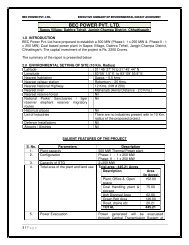
![ks= h; dk;kZy;] {ks= h; dk;kZy](https://img.yumpu.com/50492507/1/190x245/ks-h-dkkzy-ks-h-dkkzy.jpg?quality=85)
